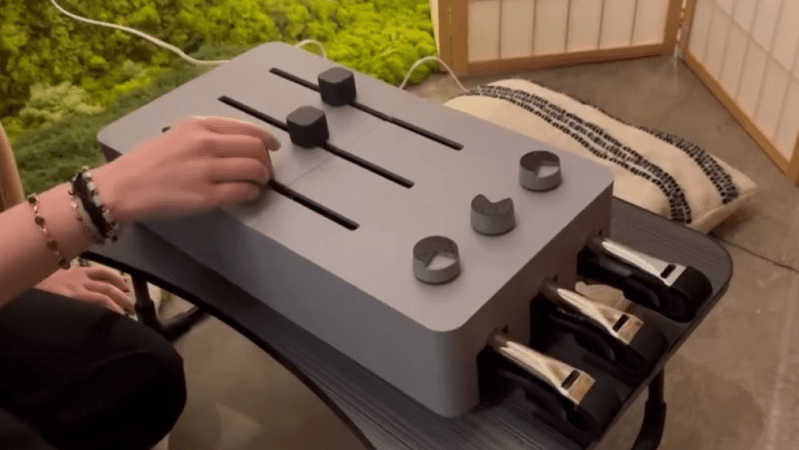Ever have one of those ideas that’s just so silly, you just need to run with it? [Chris] from Sound Workshop ran into that when he had the idea that became the Pneumatone: a woodwind instrument that plays like a synth.
In its 3D printed case, it looks like a giant polyphonic analog synth, but under the plastic lies a pneumatic heart: the sound is actually being made by slide whistles. We always thought of the slide whistle as a bit of a gag instrument, but this might change our minds. The sliders on the synth-box obviously couple to the sliders in the whistles. The ‘volume knobs’ are actually speed controllers for computer fans that feed air into the whistles. The air path is possibly not ideal– there’s a bit of warbling in the whistles at some pitches– but the idea is certainly a fun one. Notes are played by not blocking the air path out the whistle, as you can see in the video embedded below.
Since the fans are always on, this is an example of a drone instrument, like bagpipes or the old hacker’s favourite, the hurdy gurdy. [Chris] actually says in his tip– for which we are very thankful– that this project takes inspiration not from those projects but from Indian instruments like the Shruthi Box and Tanpura. We haven’t seen those on Hackaday yet, but if you know of any hacks involving them, please leave a tip.
















cool, but it doesn’t look like a “giant analog synth” at all.
The first synthesizer was a woodwind instrument (at least in part): the pipe organ.
No it wasn’t. An organ and a synthesizer are two different things. Also 3 slide whistles in a box still isn’t a synthesizer. If it is, we might as well call a piano a guitar, they both make sounds, they both have strings. The CD and the vinyl record are the same too, since they both are circular devices with a hole in the middle and hold a sound recording.
A pipe organ does additive synthesis: you select one or more stops to make the sound you want. A synthesizer does fundamentally the same thing: make a sound from building blocks.
A synthesizer constructs the sound signal in an electrical form before it is made audible. The word synthetic is used in the sense that the sound it’s fabricated – it is not produced by the physical instrument itself.
A pipe organ just plays a multitude of pipes – it’s the real deal, not synthetic – not a synthesizer.
Or, if a pipe organ is a synthesizer then a classical guitar is. You select one or more strings and bars to make the sound you want. Their sounds add together.
By your criteria, every polyphonic instrument is a synthesizer.
A pipe organ is definitely the analog version of a synthesizer! It’s purpose was to mimic sounds such a true.peta and flutes but with greater range and also to create new sounds through combination. Put another way, the synthesizer is basically a digital pipe organ with infinite stops
In a guitar, you select strings and bars to create a chord: every string plays a different note. In a pipe organ, you use the stops to select multiple pipes to play the same note, adding those sounds together to create a new sound.
Or, if you pick the same note on different strings and stretch it a little, you can modulate the note and create harmonics etc. That’s additive synthesis, except the guitar is not doing the synthesis but simply vibrating two strings and the addition of the two sounds happens in a real physical medium, or, the air around the instrument.
Same with the pipe organ. Meanwhile, a synthesizer uses two oscillators that in themselves do not emit sound but an electronic signal which is summed together electronically, and then another piece of equipment (amplifier and speaker) fabricates the actual sound based on the signal.
But the pipe organ itself did not synthesize (fabricate) the sound. It merely produced the components which added together naturally. The point was the same, but the function of the device was different.
The first well-known electronic synthesizer, the Moog, was not polyphonic; it could only play one note at a time, like most wind instruments.
And other earlier synths were also that way – monophonic – like the Ondens Martenot or the Theremin. They used the beat frequency between two oscillators to create a single tone and that was that.
The point of the word “synthesizer” is indeed that the sound is constructed first by electronic means to make the tone before it is turned into audible sound, vs. actual instruments which produce an audible sound first and that then excites different resonances to make the tone.
Seriously…? 😐
Ya super serious
The “warbling” you’re hearing is beating, which happens when two notes that are close, but not exactly equal to, each other are sounded simultaneously. The frequency of the beat is equal to the discrepancy. So 600 Hz and 602Hz tones played together will give a beat tone at 2 Hz (which you perceive as a “warble”). You can also get a beat tone when the two frequencies are close to being related by a small-digit fraction. So, for example, 600 Hz and 404Hz, which are close to 3/2, will also give an audible beat.
Indeed. A phenomenon which has been used to tune stringed instruments for centuries.
There absolutely is beating in the video!
There’s a bit later on where he demonstrates the sliding feature, and the beat goes away and there is still an unsteady “airiness” in the sound of the flute that [Chris] mentions in the video description as something he hopes to get rid of. That’s what the article was trying (and failing) to reference.
It’s marvelously annoying! Great for breaking leases and harassing the neighbor’s dogs!
Actually, wouldn’t this be considered a drone?
i wish it was a step sequencer
Yeah it needs a microcontroller to pulse the fans and give you some arpeggiator functions :)
Where are the linear actuators and gated airflow so this can play itself? That’s what I’m expecting here not a manual 3 slide whistles blown by weak air.
Reminds me of a calliope